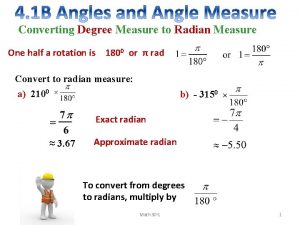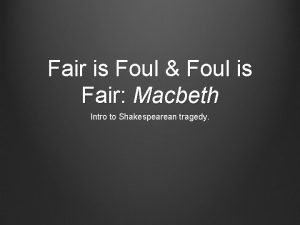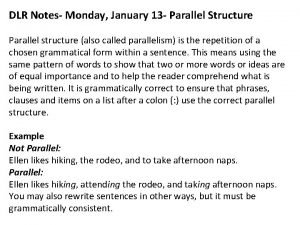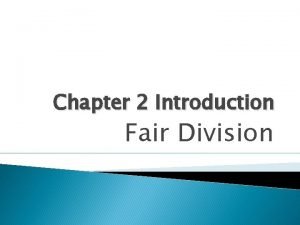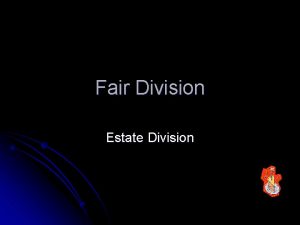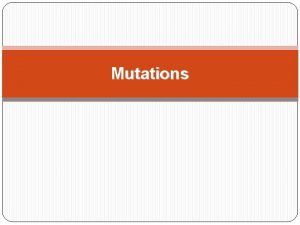Not Everyone Likes Mushrooms Fair Division and Degrees













![References I [LR 09] C. Lindner and J. Rothe. Degrees of Guaranteed Envy. Freeness References I [LR 09] C. Lindner and J. Rothe. Degrees of Guaranteed Envy. Freeness](https://slidetodoc.com/presentation_image_h2/7a6603866fdccc14c00b0cf75ea088e2/image-14.jpg)
![References II [EP 06] J. Edmonds and K. Pruhs. Cake cutting really is not References II [EP 06] J. Edmonds and K. Pruhs. Cake cutting really is not](https://slidetodoc.com/presentation_image_h2/7a6603866fdccc14c00b0cf75ea088e2/image-15.jpg)
![References III [RW 98] J. Robertson and W. Webb. Cake-Cutting Algorithms: Be Fair If References III [RW 98] J. Robertson and W. Webb. Cake-Cutting Algorithms: Be Fair If](https://slidetodoc.com/presentation_image_h2/7a6603866fdccc14c00b0cf75ea088e2/image-16.jpg)
- Slides: 16

Not Everyone Likes Mushrooms: Fair Division and Degrees of Guaranteed Envy-Freeness* Second GASICS Meeting Computational Foundations of Social Choice Aachen, October 2009 Claudia Lindner Heinrich-Heine-Universität Düsseldorf *To be presented at WINE’ 09 C. Lindner and J. Rothe: Degrees of Guaranteed Envy-Freeness in Finite Bounded Cake-Cutting Protocols

Overview • Motivation • Preliminaries and Notation • Degree of Guaranteed Envy-Freeness (DGEF) • DGEF-Survey: Finite Bounded Proportional Protocols • DGEF-Enhancement: A New Proportional Protocol • Summary Fair Division and the Degrees of Guaranteed Envy-Freeness 2

Motivation Fair allocation of one infinitely divisible resource • Fairness? ⇨ Envy-freeness • Cake-cutting protocols: continuous vs. finite ⇨ finite bounded vs. unbounded • Envy-Freeness & Finite Boundedness & n>3? Degree of guaranteed envy-freeness • Approximating fairness • • Minimum-envy measured by value difference [LMMS 04] Approximately fair pieces [EP 06] Minimum-envy defined by most-envious player [BJK 07] … Fair Division and the Degrees of Guaranteed Envy-Freeness 3

Preliminaries and Notation Resource • Players with • Pieces : • Portions : • ℝ ∅; ∅; ∅, ∅, and Player ‘s valuation function • Fairness criteria • Proportional: • Envy-free: • ℝ Fair Division and the Degrees of Guaranteed Envy-Freeness 4

Degree of Guaranteed Envy-Freeness I • Envy-free-relation (EFR) Binary relation from player for , , such that: to player • Case-enforced EFRs ≙ EFRs of a given case • Guaranteed EFRs ≙ EFRs of the worst case Fair Division and the Degrees of Guaranteed Envy-Freeness 5

Degree of Guaranteed Envy-Freeness II Given: Heterogeneous resource , Players and • Rules: Halve in size. Assign to and to. ⇨ G-EFR: 1 • Worst case: identical valuation functions Player : and ⇨ 1 CE-EFR Player : and • Best case: matching valuation functions Player : and ⇨ 2 CE-EFR Player : and • Fair Division and the Degrees of Guaranteed Envy-Freeness 6

Degree of Guaranteed Envy-Freeness III Degree of guaranteed envy-freeness (DGEF) Number of guaranteed envy-free-relations ≙ Maximum number of EFRs in every division Proposition Let d(n) be the degree of guaranteed envy-freeness of a proportional cake-cutting protocol for n ≥ 2 players. It holds that n ≤ d(n) ≤ n(n− 1). Proof Omitted, see [LR 09]. Fair Division and the Degrees of Guaranteed Envy-Freeness 7

DGEF-Survey of Finite Bounded Proportional Cake-Cutting Protocols Theorem For n ≥ 3 players, the proportional cake-cutting protocols listed in Table 1 have a DGEF as shown in the same table. Table 1: DGEF of selected finite bounded cake-cutting protocols [LR 09] Proof Omitted, see [LR 09]. Fair Division and the Degrees of Guaranteed Envy-Freeness 8

Enhancing the DGEF: A New Proportional Protocol I Significant DGEF-differences of existing finite bounded proportional cake-cutting protocols • Old focus: proportionality & finite boundedness • New focus: proportionality & finite boundedness & maximized degree of guaranteed envy-freeness • Based on Last Diminisher: piece of minimal size valued 1/n + Parallelization • Fair Division and the Degrees of Guaranteed Envy-Freeness 9

Enhancing the DGEF: A New Proportional Protocol II Proposition For n ≥ 5, the protocol has a DGEF of . Proof Omitted, see [LR 09]. ⇨ Improvement over Last Diminisher: Fair Division and the Degrees of Guaranteed Envy-Freeness 10

Enhancing the DGEF: A New Proportional Protocol III Seven players A, B, …, G and one pizza 1 0 ADCB E G F DC BE F A F CBE D F C AD • C D B C E B F C FCBE DG B C F B E G Selfridge– Conway [Str 80] … Everybody is happy! Well, let’s say somebody… Fair Division and the Degrees of Guaranteed Envy-Freeness 11

Summary and Perspectives Problem: Envy-Freeness & Finite Boundedness & n>3 ⇨ DGEF: Compromise between envy-freeness and finite boundedness – in design stage • State of affairs: survey of existing finite bounded proportional cake-cutting protocols • Enhancing DGEF: A new finite-bounded proportional cake-cutting protocol • ⇨ Improvement: • Scope: Increasing the DGEF while ensuring finite boundedness Fair Division and the Degrees of Guaranteed Envy-Freeness 12

Questions? ? ? THANK YOU Fair Division and the Degrees of Guaranteed Envy-Freeness 13
![References I LR 09 C Lindner and J Rothe Degrees of Guaranteed Envy Freeness References I [LR 09] C. Lindner and J. Rothe. Degrees of Guaranteed Envy. Freeness](https://slidetodoc.com/presentation_image_h2/7a6603866fdccc14c00b0cf75ea088e2/image-14.jpg)
References I [LR 09] C. Lindner and J. Rothe. Degrees of Guaranteed Envy. Freeness in Finite Bounded Cake-Cutting Protocols. Technical Report ar. Xiv: 0902. 0620 v 5 [cs. GT], ACM Computing Research Repository (Co. RR), 37 pages, October 2009. [BJK 07] S. Brams, M. Jones, and C. Klamler. Divide-and. Conquer: A proportional, minimal-envy cake-cutting procedure. In S. Brams, K. Pruhs, and G. Woeginger, editors, Dagstuhl Seminar 07261: “Fair Division”. Dagstuhl Seminar Proceedings, November 2007. [BT 96] S. Brams and A. Taylor. Fair Division: From Cake-Cutting to Dispute Resolution. Cambridge University Press, 1996. [EP 84] S. Even and A. Paz. A note on cake cutting. Discrete Applied Mathematics, 7: 285– 296, 1984. Fair Division and the Degrees of Guaranteed Envy-Freeness 14
![References II EP 06 J Edmonds and K Pruhs Cake cutting really is not References II [EP 06] J. Edmonds and K. Pruhs. Cake cutting really is not](https://slidetodoc.com/presentation_image_h2/7a6603866fdccc14c00b0cf75ea088e2/image-15.jpg)
References II [EP 06] J. Edmonds and K. Pruhs. Cake cutting really is not a piece of cake. In Proceedings of the 17 th Annual ACM-SIAM Symposium on Discrete Algorithms, pages 271– 278. ACM, 2006. [Fin 64] A. Fink. A note on the fair division problem. Mathematics Magazine, 37(5): 341– 342, 1964. [Kuh 67] H. Kuhn. On games of fair division. In M. Shubik, editor, Essays in Mathematical Economics in Honor of Oskar Morgenstern. Princeton University Press, 1967. [LMMS 04] R. Lipton, E. Markakis, E. Mossel, and A. Saberi. On approximately fair allocations of indivisible goods. In Proceedings of the 5 th ACM conference on Electronic Commerce, pages 125– 131. ACM, 2004. Fair Division and the Degrees of Guaranteed Envy-Freeness 15
![References III RW 98 J Robertson and W Webb CakeCutting Algorithms Be Fair If References III [RW 98] J. Robertson and W. Webb. Cake-Cutting Algorithms: Be Fair If](https://slidetodoc.com/presentation_image_h2/7a6603866fdccc14c00b0cf75ea088e2/image-16.jpg)
References III [RW 98] J. Robertson and W. Webb. Cake-Cutting Algorithms: Be Fair If You Can. A K Peters, 1998. [Ste 48] H. Steinhaus. The problem of fair division. Econometrica, 16: 101– 104, 1948. [Ste 69] H. Steinhaus. Mathematical Snapshots. Oxford University Press, New York, 3 rd edition, 1969. [Str 80] W. Stromquist. How to cut a cake fairly. The American Mathematical Monthly, 87(8): 640– 644, 1980. [Tas 03] A. Tasnádi. A new proportional procedure for the nperson cake-cutting problem. Economics Bulletin, 4(33): 1– 3, 2003. Fair Division and the Degrees of Guaranteed Envy-Freeness 16
 The rebel will sit quietly when-
The rebel will sit quietly when- Hope youre doing well
Hope youre doing well Convert from degrees to radians 225
Convert from degrees to radians 225 One half radian
One half radian Foul is fair and fair is foul literary device
Foul is fair and fair is foul literary device Literary devices macbeth act 1
Literary devices macbeth act 1 Fair is foul and foul is fair macbeth
Fair is foul and foul is fair macbeth Syntax literary device
Syntax literary device Fair play slide
Fair play slide Examples of fair is foul and foul is fair in macbeth
Examples of fair is foul and foul is fair in macbeth Nn budding
Nn budding 14 line sonnets
14 line sonnets I would rather eat potatoes than to eat rice answer
I would rather eat potatoes than to eat rice answer Ralph likes 25 not 24
Ralph likes 25 not 24 Parallel structure notes
Parallel structure notes Oh shiitake mushrooms bill
Oh shiitake mushrooms bill Paul cryan
Paul cryan



